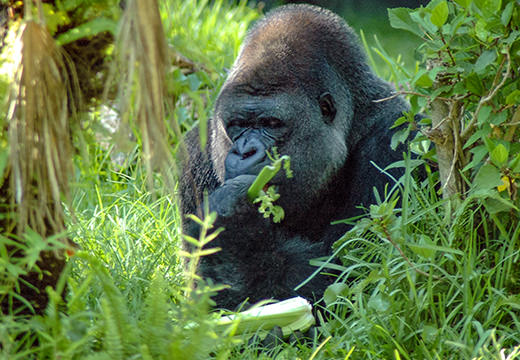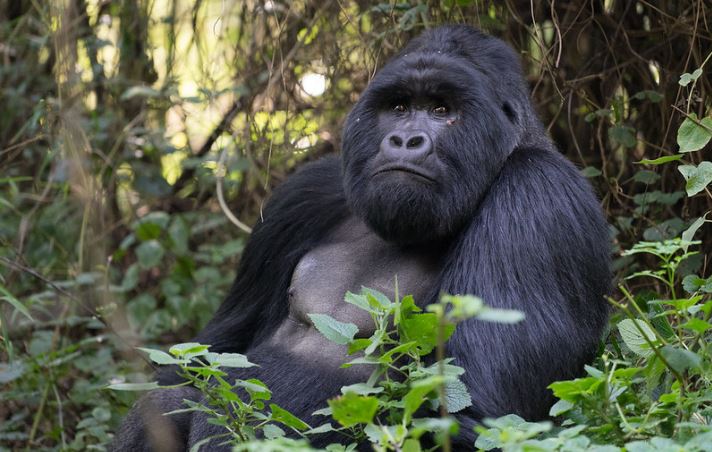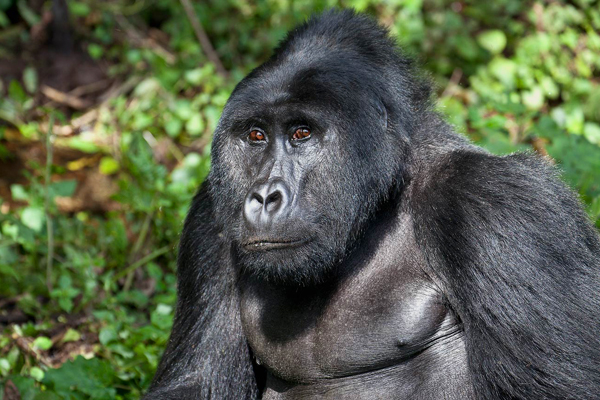
What a gorilla’s diet comprises
What a gorilla’s diet comprises
What a gorilla’s diet comprises : What do gorillas consume or rather what does a gorilla’s diet comprise? These are questions that have always piqued our children’s interest, especially the younger ones. They are herbivores and eat mostly green leaves, bamboo shoots, and seeds as their main food.
Gorillas are classified into two species, each of which has two subspecies within it. You may find two types of western gorillas in the wild: Cross River gorillas and Western Lowland gorillas. Gorillas of the Eastern Lowlands and Mountain Gorillas are two subspecies of the Eastern Lowlands Gorilla.
Bwindi Impenetrable national park in Uganda and Mgahinga Gorilla national park in Rwanda are the only places in the world where travelers may see mountain gorillas. In the Democratic Republic of Congo, mountain gorillas can only be seen in Volcanoes National Park and Virunga National Park.
98 percent of our DNA is shared by gorillas and humans. These great apes live and travel in groups of 2 to 40 individuals with the silverback as the family’s leader.
When the Silverback is elderly, another Silverback takes over. The Silverback determines where to feed and when to feed. He also handles disagreements, fights and guards the family from other gorilla groups, among other things.
DR Congo, Rwanda, and Uganda are home to the critically endangered mountain gorillas. It is possible to follow eight habituated gorilla groups in the Virunga national park in the Democratic Republic of Congo. There are 18 habituated mountain gorilla families in Uganda’s Bwindi Impenetrable National Park, which contains the world’s largest population of gorillas.
A second habituated gorilla population, the Hirwa gorilla group, has arrived from Volcanoes national park in Rwanda to Mgahinga Gorilla national park in Uganda. For the time being, only 10 of Rwanda’s habituated gorilla families are accessible for tourists to monitor, with the others being used for scientific study.
Their native environment and the time of year determine what they consume. Green plants, such as bamboo shoots, fruits, grasses, and herbs make up the bulk of a gorilla’s diet and thus What a gorilla’s diet comprises. Ash and dirt are also consumed by gorillas in order to control their digestive system, neutralize toxic chemicals contained in some of the plants they eat, and provide nutrients to their system that are not found in the plants they eat, As a source of protein, they also eat ants, snails, caterpillars, termites, and other insects in a tiny amount of approximately 2 percent.
Mountain gorillas differ from lowland gorillas in size and eating habits in that mountain gorillas are slightly smaller than lowland gorillas and primarily feed on vegetation or green plants because they live in rain forests at a high altitude or elevation that does not support a lot of fruit growth compared to lowland gorillas which are slightly larger in size.

Mountain gorillas in Africa’s rainforests consume around 142 plant species, with leaves, stems, and bamboo shoots accounting for approximately 86% of their diet, with edible roots accounting for 7%, flowers accounting for 3%, fruits accounting for 2%, and ants, grubs, and snails accounting for 2%.
Gorillas, like humans, have a set of 32 teeth that they use for chewing and processing the plants they eat, with the exception of adult gorillas, who acquire long pointed canines when they reach maturity and use them to fight other male gorillas. An adult male gorilla consumes around 30 kilos of vegetation per day, whereas a female gorilla consumes approximately 18 kilograms of vegetation per day. Mountain gorillas seldom drink water because the foliage they eat is very delicate, delicious, and juicy, storing and providing half of the water that the gorillas require to thrive, and they also obtain water from the morning mist.
Gorillas are selective when it comes to eating plants, since they don’t eat everything in one area, but instead eat the roots of one plant, the stems of another, the leaves of another, and so on. This allows the vegetation to grow back because they rotate from one place to another.
In addition to chest beating, gorillas use approximately 25 other noises to communicate with one another. While searching for food, gorillas speak with one other to convey their feelings of anguish and assist each other. When mating, they also communicate. Unlike other animals, gorillas are herbivores that are completely dependent on their environment for food, shelter, and other resources. But they are essentials for their existence, if you will.
It is estimated that gorillas can live up to 35 years. In addition, female gorillas give birth to one infant every 2 to 3 years, resulting in a total of 4 to 6 children throughout their lifespan, which makes population expansion difficult and, thus, makes it difficult for the gorilla population to expand as a whole. In the first five months after birth, the infants can weigh between 3 and 4 kilos and are fed breast milk every hour until they reach the age of four. Adult male gorillas weigh between 136 and 196 kilos and stand between 5 and 9 feet tall.
What is the best time to visit gorillas?
However, the best time to see gorillas is during the dry season between the months of June and February when there is less rainfall and drier terrain for gorilla trekking, as well as easier sightings of the gorillas due to short vegetation in the forests, as opposed to visiting during the wet season between March and May and October to November when it rains.

What is the cost of a gorilla Trekking permit in Rwanda, Uganda and Congo?
Those who wish to track mountain gorillas in Rwanda’s Volcanoes National Park can purchase a permit for USD 1500. In Uganda’s Bwindi Impenetrable National Park and Mgahinga Gorilla National Park, a gorilla trekking permit costs USD 700 for foreign non-residents and USD 600 for foreign residents. For USD 400 per person, you may monitor mountain gorillas in Virunga national park or eastern lowland ones in Kahuzi-Biega National Park in the Democratic Republic of the Congo.


